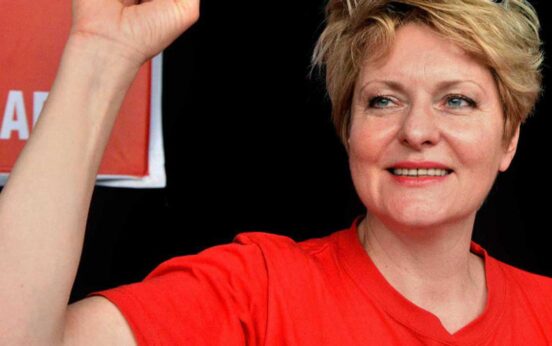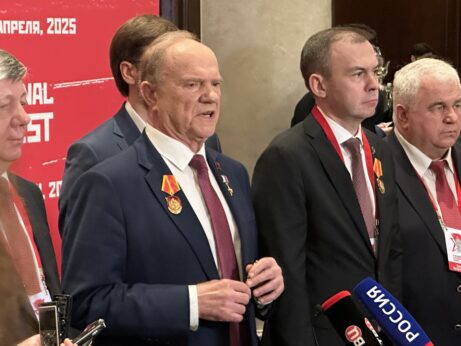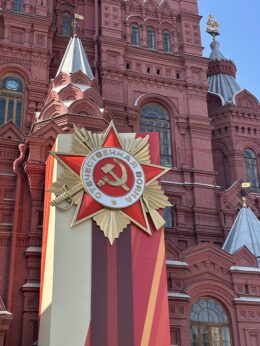
MOSCOW—Walking along the thoroughfares of the Russian capital these days, it’s easy to feel as though you’ve gone “Back to the Future.” Like Marty McFly in the classic 1985 movie, visitors to Moscow might imagine they’ve traveled back in time to the Soviet past, when socialism beat Hitler and the future of communism beckoned on the horizon.
Everywhere, crimson banners bearing the word “Победа!”—“Victory!”—flap in the wind next to giant billboards of heroic Soviet soldiers on the battlefields of World War II. Golden hammer-and-sickle emblems festoon the buildings on Red Square, and out at the old Exhibition of Economic Achievements—a grand, Disneyland-sized theme park extolling the accomplishments of the Soviet Union—the statues of workers and collective farmers are all polished up like new.
Down in Volgograd, where Hitler’s troops met their Waterloo back in ’42, the local air hub has just been rechristened “Stalingrad International Airport,” and rumors suggest the whole city may soon return to its old name.
What’s going on? Has Russia gone red again? Is it time to rock out to The Beatles and sing along to “Back in the USSR”? Well, not quite.

Tatiana Desiatova, a straight-talking Communist with a reputation for bluntness, says there is a much simpler and more cynical explanation for all of it: “The oligarchs have built nothing but their own wealth, so now we see them cleaning up the old monuments, putting out the old Soviet symbols, singing the old songs, and celebrating some of the USSR’s achievements in an attempt to bolster their own flagging legitimacy.”
Desiatova is the Advisor to the Deputy Head of the International Commission of the Moscow City Committee of the Communist Party of the Russian Federation. It’s a long-winded title, but what’s immediately apparent when you meet Tatiana Desiatova is that you’re dealing with a person who knows Russia and knows the world.
A third-generation Communist and lifelong political activist, she spoke with People’s World in Moscow last week on the sidelines of the Second International Antifascist Forum, a meeting which brought together 164 delegates from 91 countries to analyze the resurgence of fascism around the world and share strategies on how to resist it.
With the whole country decked out for the upcoming 80th anniversary of Hitler’s defeat on May 9th, she said there’s definitely a celebratory spirit in the air, a sense of pride among Russians for the fact that their country helped save the world from the Nazis. It’s a legacy that the state is trying to co-opt and append to its own increasingly costly war in Ukraine.
But that legacy belongs to the Soviet people, not to the president and the capitalist class around him which rules present-day Russia, Desiatova said. “Putin is completely part of the oligarch clique,” she emphasized, even though he’s tried to portray himself as a defender of law and order and public wellbeing.
“The economy got better after the disastrous years of Boris Yeltsin and the looting of public wealth that happened under privatization,” she said, and the public understandably gave Putin a lot of credit for that turnaround. But the question arises: Is the day coming when that’s no longer enough?
Disaster capitalism
The scale of the catastrophe that befell Russians and the other peoples of the former Soviet Union after the overthrow of socialism is hard to exaggerate. The “shock therapy” prescribed by U.S. economists in the 1990s nearly destroyed the country.

If you think inflation in the U.S. has been bad these last few years, imagine prices rising by more than 2,000% in just three years—a $1 cup of coffee skyrocketing to $20. That’s exactly what happened in Russia after price controls were eliminated in 1991.
Public healthcare systems collapsed at the same time, and economic stress triggered an explosion of mental illness and alcoholism. Life expectancy plummeted. For women, it sank from 74 to 71 years, while men, who had been living to 64 on average, could expect to die by the age of 57 by 1994.
Mass layoffs led to millions of unemployed. For those lucky enough to keep their jobs, though, things weren’t much better. Wages in both the public and private sectors went unpaid for months or even years at a time. The collapse of the ruble in 1998 made things worse.
But perhaps the most sinister development of those years was the corrupt privatization of the public property that had belonged to the people of the Soviet Union. The first sell-off of socialist property was launched by Yeltsin in 1992 under the pretext of a “fair and open” process. The 148 million citizens of Russia were issued “privatization checks,” or vouchers, supposedly representing their individual share of the publicly-owned national wealth.
These vouchers could be used to buy shares of state enterprises. A small parasitical class who’d managed to accumulate some wealth—whether by embezzling it from their public sector employers, by trading on the black market, or via the businesses that the last Soviet leader Mikhail Gorbachev had legalized in the 1980s—used their resources to scour the country, buying up as many of these vouchers as possible from citizens desperate for cash.
Within less than two years, this now fully-fledged capitalist class gobbled up nearly 70% of the Soviet economy. Whole industries were put on the auction block and sold to the highest bidder. The most valuable companies were still in state hands by the mid-’90s, however, and with his government near collapse, Yeltsin and the new rulers of capitalist Russia came up with another scheme.

As the 1996 presidential elections neared, it was obvious that Communist Party candidate Gennady Zyuganov was likely to win. The Russian people had gotten a taste of capitalism and didn’t like it, so Yeltsin had to act fast.
With the mafia in charge of Moscow’s streets and the government out of rubles, Yeltsin’s cabinet turned to a secret plot known as “Loans for Shares.” Essentially, the richest and most corrupt among the new oligarchical class were offered huge blocks of shares of public enterprises in exchange for billions of dollars in loans to the state.
From the very beginning, it was intended that the government would intentionally default on these “loans,” allowing the capitalists to keep the profitable public sector corporations they held as collateral—steel companies, mines, oil companies, shipping companies. Yeltsin and the oligarchs worked out in advance exactly who would get what and for what price. Figures like Boris Berezovsky and Roman Abramovich picked up entire industries for a steal.
In return, the oligarchs did everything possible to get Yeltsin re-elected, spending millions on his campaign. Together with the election interference orchestrated by the administration of U.S. President Bill Clinton, they pulled it off. But the sham of “Russian democracy” couldn’t paper over the corruption of the regime and the theft it had facilitated. Yeltsin, the notorious alcoholic, stumbled along in office for a few more years before eventually resigning on New Year’s Eve 1999 and handing over the reins to Putin.
The new president’s rule was characterized by an emphasis on order; the mafia was brought to heel, and the oligarchs were kept in line (but also allowed to hold onto their ill-gotten gains). High oil prices, a cancellation of Soviet debts by some major lenders, and the eventual attraction of legitimate foreign investment from countries like China helped stabilize the country’s finances.
In urban areas, there eventually emerged a semblance of economic normality, even though poverty and limited job prospects continued to plague the population of the countryside. Ethnic minorities, meanwhile, found themselves increasingly relegated to low-wage service sector jobs. Inequality continued to accelerate during Putin’s first two decades in power, but the employment situation improved, wages were paid on time, and family incomes finally started to grow.
After the disaster of that first decade under capitalism, stability was enough for many people, at least for a while.
Russia (and Ukraine) today
Putin “has lived on that record for a long time,” Desiatova argued, “but it can’t last forever.” She said that is why there has been an increase in the state’s “selective coopting of the Soviet legacy” over the last several years, especially as it relates to war and other themes that easily lend themselves to nationalistic ends.
“He knows that the memory of the Soviet Union and its accomplishments,” foster pride in many Russians and that “the help the USSR provided to other countries still buys Russia a lot of goodwill in the developing world” and among nations struggling against imperialism.

The Russian state manipulates those positive sentiments linked to the past in order to raise its own profile at home and abroad, opportunistically cherry-picking from the Soviet record while still taking advantage of every chance to trash Lenin, Marxist ideology, and socialist economics.
For the Communist Party of the Russian Federation (CPRF), the evolution of how the Soviet past is treated has produced new challenges. In previous years, the party was the sole defender of the USSR and its achievements and was the political home for Russians who felt jaded about their new capitalist reality.
As Putin’s party gradually ate into its share of support, however, the CPRF has become a shrinking political force. It has to work harder these days to make the case for socialism, especially among those generations born after the fall of the Soviet Union who have no memory of a time before the oligarchs.
The economic reality of life under capitalism leaves many people consumed with just trying to make ends meet and little time to think about alternatives—the norm for workers in all capitalist economies. And for those who were scarred by the chaos of the 1990s, there is a reluctance to rock the boat.
The coming of the Ukraine war in 2022 complicated things even further.
The CPRF is recognized by all, both at home and abroad, as being behind the war effort when it comes to liberating the oppressed peoples of eastern Ukraine (in Donetsk and Lugansk, the Donbass areas in particular) from the rule of the far-right, fascist, and neo-Nazi elements that influence the Ukrainian government installed by the 2014 U.S.-backed coup.
The CPRF is not of one mind with Putin, however, when it comes to the nature of the war.
Having personally witnessed what was happening in the Donbass before Russian troops entered in 2022, Desiatova said, “the situation for the ethnic Russians living there was actually much worse than even the international media showed on television.” Violence and human rights abuses by fascist forces were widespread.
The CPRF had advocated action to help the people of the Donbass for years, from 2014 to 2022, but for most of that time, the Putin government didn’t seem to care much about the fascist terror underway in Ukraine. Instead, he preferred to continue communicating and bargaining with Ukrainian oligarchs, supplying only limited help to the rebel forces there.
The CPRF was therefore somewhat surprised when suddenly in late 2021 the president seemed to take greater interest in assisting the people of the Donbass and began to talk of the need to combat fascism. The U.S. intention to expand NATO was always an ever-present part of the picture, but significant provocations aimed at speeding up that process and further isolating Ukraine from Russia appeared to move Putin’s hand.
In February 2022, the Russian government launched the “Special Military Operation,” sending soldiers across the frontier in force. Desiatova said that most believe it was necessary to assist the people in the Donbass, but differences exist as to whether “there may have been other means to accomplish that” besides an outright invasion.
Now, three years and thousands of dead later, the situation remains bleak, and hopes for peace seem narrow. “So many people are dying, but only the oligarchs of Russia, Ukraine, and the U.S. win,” Desiatova lamented.
So, while some commentators in the Western left media portray the CPRF as simply mimicking the talking points of the Putin government, the party’s views on the war are far more nuanced and complex than many recognize.
Asked about the matter, Desiatova pointed to an analysis put forward by Denis Parfenov, a CPRF Member of the State Duma, titled “The People Need Peace” (English translation).
Turning to Lenin, Parfenov argued that the war in Ukraine exhibits elements of two types of war: an imperialist war and a war for national liberation. The CPRF, according to Parfenov and Desiatova, clearly recognizes that there is a proxy war between U.S.-NATO imperialism and the capitalist ruling class of Russia, but the fight in Ukraine is far more than that.
The people in the ethnically Russian Donbass region of eastern Ukraine, the party maintains, were literally struggling for their survival before 2022 against the Ukrainian army and fascist militias like the Azov Battalion. Their struggle, often led by Communists and left patriots, took the form of a “people’s revolution with a socialist tinge,” as Parfenov put it. After Russian troops entered the area, however, Putin suppressed this development and has not allowed the Communist Party to take part in elections there.
Regardless, the war is now a reality, and in order to secure the liberty and security of the people living in the Donbass, the CPRF gives support to the forces struggling there and recognizes the geopolitical complexities involved. The tasks of de-Nazifying Ukraine, blocking NATO expansion, and protecting oppressed people are “fundamental issues,” according to Parfenov.
But, he cautions, “there should be no illusions” about Putin and the capitalist class that rules Russia. “The people who have gathered to ‘de-Nazify’ Ukraine are people,” Parfenov argued, “who themselves revere fascist philosophers like Ivan Ilyin and allocate money to anti-Soviet and anti-Communist causes.”
Progressives who oppose fascism should not become confused, he said, about the nature of the Russian government, which “is by no means a socialist state that brings liberation from exploiters or ideas of social justice to other nations.”
Desiatova expressed hope that more people who have questions about the CPRF and the Ukraine war will read Parfenov’s paper before making assumptions.
Communists forward
The phrase “Communists forward!” was repeated by numerous speakers on the platform during the Second International Antifascist Forum in Moscow last week.

When Hitler’s armies invaded the Soviet Union in 1941, the people rose up to defend their homeland. At the head of their battalions—whether in the official ranks of the Red Army or among the partisans fighting behind enemy lines—were members of the Communist Party. They were the first to volunteer, the first to charge against the Nazis.
Today, as they commemorate the 80th anniversary of the victory over fascism and grapple with the difficulties of politics under the Putin government, the members of the CPRF are again sounding the call, “Communists forward!” They’re fighting for a Russian working class increasingly feeling the strain of life under a capitalism beset by crisis, sanctions, and war.
Looming ahead of them is a struggle against what Desiatova called “the next round of privatization.” After a falling out between Putin and some of the oligarchs, a significant amount of assets were seized and re-nationalized—some $10.8 billion dollars’ worth in the last three years, at least 67 companies in 2024 alone.
The Communists have urged that this property, much of it stolen from the Soviet people so long ago, should remain in public hands. Finance Minister Anton Siluanov has signaled, however, that the government has no intention of letting that happen.
“We plan to intensify the privatization of property coming into the treasury,” he told a group of state leaders in mid-March. If the government proceeds with its stated plan, the assets will simply change hands, passing from one set of oligarchs to another set currently in favor in the Kremlin.
It all seems to prove Tatiana Desiatova right. Putin sits at the head of a clique that calls the shots on everything—from economics to politics to war. Neither the plastering of Moscow with Soviet symbols and red flags nor the renovation of socialist monuments can hide the reality that Russia is a capitalist state ruled by a class of parasitical oligarchs.











